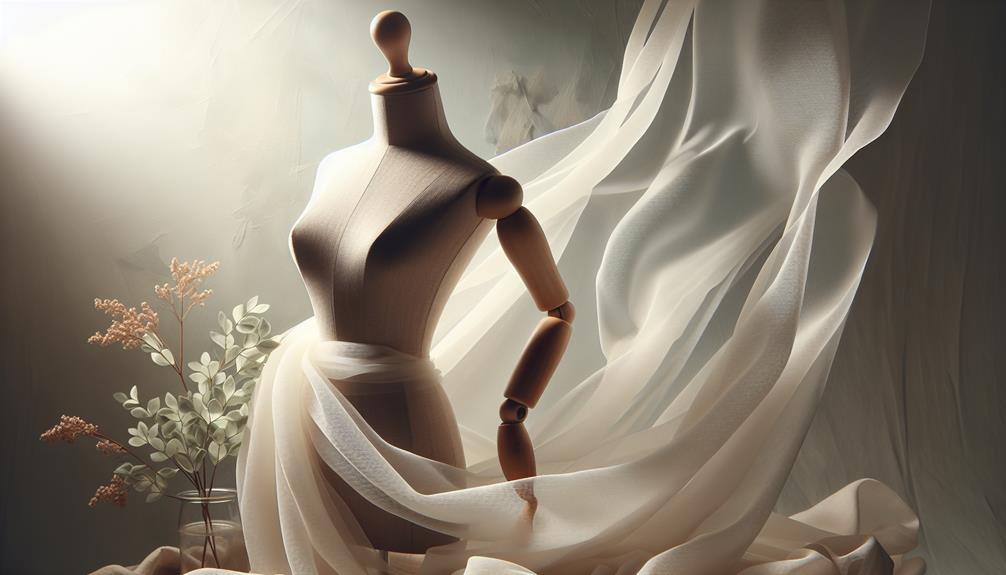Yes, chiffon is definitely a breathable fabric. It's crafted from materials like silk or synthetic fibers, such as polyester and nylon. The weaving process of chiffon creates little openings that allow air and moisture to pass through easily, making it super comfortable, especially on warm days. This light and airy quality doesn't trap heat and moisture like some heavier fabrics do, which keeps you feeling cool and fresh. It's an excellent choice for everything from elegant evening wear to casual summer dresses. There's much more to chiffon's unique traits that make it a favorite for clothing and other uses.
Table of Contents
Key Takeaways
- Chiffon fabric allows air and moisture to pass through, enhancing breathability.
- Its unique weave creates micro-openings that facilitate air circulation.
- Chiffon does not trap heat, making it ideal for warm weather.
- The fabric's lightweight nature contributes to its ability to regulate body temperature.
- Chiffon's breathability is due to its composition and the weaving process used.
Understanding Chiffon Fabric
Chiffon's lightweight and sheer nature makes it a popular choice for elegant and flowing garments. I've always loved how it drapes gracefully, creating a soft silhouette that's perfect for evening wear or a casual summer dress. When you hold a piece of chiffon, it's almost like holding a cloud—so light and airy. This unique character comes from the way chiffon is woven, which we'll get into later.
Another great thing about chiffon is its versatility. It's not just for fancy dresses. I've seen it used in scarves, blouses, and even as an overlay to add a touch of finesse to different outfits. Despite its delicate appearance, it's surprisingly durable, which makes it a go-to fabric for many of my projects.
Working with chiffon can be a bit tricky due to its slippery texture. I've learned that it requires a gentle hand and a lot of patience, especially when cutting and sewing. But once you master those skills, the possibilities with chiffon are practically endless. It's all about embracing its fluidity and allowing your creative instincts to take over.
Composition of Chiffon
Now, let's talk about what chiffon is made of and how it's put together.
Chiffon can be crafted from different fibers like silk or synthetic materials, which affects its feel and breathability.
We'll also look at how the weaving process of chiffon contributes to its unique, lightweight texture.
Chiffon Fiber Types
Chiffon can be made from a variety of fibers, including silk, polyester, and nylon. Each type brings its unique qualities to the fabric.
Silk chiffon is the most luxurious option; it's super soft, has a slight sheen, and drapes beautifully, making it perfect for elegant dresses and scarves.
Polyester chiffon is more durable and affordable than silk. It's also less prone to wrinkles, which is a big plus if you're not a fan of ironing.
Nylon chiffon is similar to polyester but even stronger, making it ideal for heavy-use items like curtains.
Knowing these differences helps you make smarter choices depending on your project's needs, whether you're after luxury, durability, or a balance of both.
Chiffon Weaving Process
How do we create chiffon, and what makes its weaving process unique?
Chiffon's airy quality comes from a specific method called plain weaving. Now, this isn't just your regular weaving. It involves alternating S- and Z-twist yarns. That might sound like gibberish, right? Well, it's simple: these twists are just directions in which the yarns are spun. Alternating these twists causes slight puckers, giving chiffon that slightly rough texture and amazing drape.
The fabric's magic lies in its balance. It's lightweight but not too delicate, sturdy yet soft. The key is in the material used, usually silk or synthetic fibers, which are finely woven into sheer perfection. Mastering this balance is what makes crafting chiffon a true art form.
Breathability Explained
Let's get into what makes a fabric breathable.
We'll first look at how breathability is defined and then explore the different factors that affect it.
This will help us understand if chiffon fits the bill for being considered a breathable fabric.
Defining Fabric Breathability
Fabric breathability refers to how well a material allows air and moisture to pass through it. Essentially, it's about how easily your skin can breathe when you're wearing a certain fabric.
This is super important because it affects how comfortable you feel, especially on hot days or during physical activities. A breathable fabric won't trap heat and moisture against your skin, which helps to keep you cool and dry. Instead, it allows the air to circulate and the sweat to evaporate, which is a godsend in sticky situations.
Understanding this helps you make better choices about what to wear in different climates or situations, ensuring you're not just stylish but also comfy.
Factors Affecting Breathability
Several factors impact a fabric's breathability, including its material, weave, and thickness.
Let's break it down a bit. First, the material really sets the stage. Natural fibers like cotton and linen are champs at letting air flow, but synthetic ones can be hit or miss.
Then there's weave – how the threads are intertwined. A loose weave generally means more air passes through, making the fabric feel cooler.
Lastly, thickness plays a big role too. Thinner fabrics are typically more breathable than thicker ones because there's less material for air to penetrate.
Understanding these elements helps us gauge how comfortable a fabric will feel, especially in warmer climates. So, it's not just about the type of fabric but also how it's made.
Chiffon Vs. Other Fabrics
When comparing chiffon to other fabrics, its lightweight and airy qualities stand out significantly. This sheer material, often made from silk or synthetic fibers like polyester, brings a certain finesse that heavier fabrics simply can't match. Let's break it down a bit further.
Take cotton, for example. It's praised for its comfort and breathability, but it doesn't drape or flow quite like chiffon. Cotton pieces tend to be more casual and less suitable for the fluid, elegant lines you get with chiffon gowns or blouses.
Then there's denim—sturdy and durable, sure, but imagine trying to pull off a breezy summer look with it! It's just too clunky.
Wool, another common fabric, offers fantastic warmth and is great for those chilly months. However, it doesn't provide the lightness or delicate texture that chiffon offers. Wool garments are often more structured and less forgiving when it comes to airy, summery styles.
Airflow Characteristics in Chiffon
Chiffon's ability to allow air to pass through easily makes it a top choice for staying cool and comfortable in warmer weather. When I'm considering fabrics for a breezy summer dress or a flowing blouse, chiffon often tops my list. Its unique weave, typically from silk or synthetic fibers like polyester, features slight twists that create small puckers. These irregularities in the structure form micro-openings in the fabric, enhancing breathability.
Let's break it down a bit. Think about how a gentle breeze feels on your skin. With chiffon, even a slight wind can permeate through these micro-openings, allowing air to circulate freely around your body. This airflow isn't just a stroke of luck—it's a built-in feature of chiffon's physical makeup.
I've worn different fabrics in various climates, and I can attest that chiffon stands out. It's not just the lightweight nature but the actual capability of the fabric to facilitate air movement that impresses me. Whether it's a hot day or a balmy evening, chiffon garments seem to breathe with you, making them an excellent choice for comfort and style in warm conditions.
Temperature Regulation Properties
How does chiffon help regulate your body temperature in various weather conditions? Well, let's dive into that.
Chiffon's lightweight and airy nature plays a big role here. Because it's so light, it doesn't trap heat the way heavier fabrics might. During hot days, this means wearing a chiffon blouse or dress can actually help keep you cooler. The fabric allows air to circulate close to your skin, which helps sweat evaporate quicker and cools you down.
In cooler weather, chiffon's benefits adjust slightly. It's not insulating, but it can be layered effectively. I've found that pairing a chiffon blouse under a sweater or jacket adds minimal bulk while allowing my skin to breathe. This prevents overheating—a common problem when moving between heated indoors and the chilly outdoors during the colder months.
Essentially, chiffon's temperature regulation properties are all about balance. It won't suffocate your skin under heavy, sweaty layers, nor will it leave you shivering in the cold if used smartly with layers. It's all about how you use this versatile fabric to maintain comfort, no matter what the thermometer reads.
User Experiences With Chiffon
Why don't we explore what actual wearers of chiffon have to say about their experiences with this fabric? I've chatted with several friends and scoured online forums to gather firsthand accounts. The consensus? Chiffon's breathability is much appreciated, especially during warmer months. One friend mentioned how her chiffon blouse feels almost weightless and keeps her cool better than other materials. 'It's like a gentle breeze you can wear,' she said.
Another point that came up frequently was chiffon's versatility. A colleague highlighted how she switches between her chiffon scarves and dresses depending on the occasion and still feels comfortable all day. The fabric's lightness and airflow quality don't just limit to casual wear; they extend to formal attire too.
However, it's not all perfect. Some have noted that while chiffon is indeed breathable, its delicacy means it requires careful handling and maintenance. 'You have to be a bit cautious not to snag it on anything sharp,' a forum user advised. This makes it less ideal for some high-activity settings or when you're in a rush.
Designer Insights on Chiffon
I've always wondered how designers view chiffon, especially considering its reputation for versatility.
They must have some great tips on caring for chiffon, given how delicate it is.
Let's see what insights they've about using and maintaining this popular fabric.
Chiffon's Versatility in Design
Chiffon's incredible adaptability makes it a favorite among designers for creating everything from elegant evening wear to breezy summer dresses. It's the go-to fabric when you want something light, airy, and subtly sophisticated. I find it perfect for layering because it adds volume without weight, and its sheer nature can be played up in countless ways to enhance designs.
| Feature | Benefit |
|---|---|
| Sheer Elegance | Enhances Mystery |
| Lightweight | Easy to Layer |
| Flowy Drape | Graceful Movement |
Using chiffon allows me to experiment with silhouettes and textures, creating garments that are not just beautiful but also comfortable to wear. It's a fabric that truly blends function with fashion.
Care Tips for Chiffon
Maintaining the delicate beauty of chiffon requires some specific care tips to keep it looking its best. First off, always hand wash chiffon using cold water; hot water can damage the fibers. I'd recommend a mild detergent, something gentle enough not to harm the fabric. After washing, don't wring it out; that can lead to wrinkles and tears. Instead, lay it flat on a towel and roll it up gently to remove excess water.
For drying, avoid the dryer. Hang chiffon garments to air dry, but keep them out of direct sunlight to prevent fading. Finally, when ironing, use a low heat setting and place a cloth between the iron and the fabric to protect it.
Ideal Uses of Chiffon
Chiffon's light and airy qualities make it perfect for statement evening gowns and elegant scarves. Its sheer texture and slight shimmer give it a touch of sophistication that elevates any outfit. I've found that chiffon is also fantastic for blouses that need a bit of flow or dresses that require a graceful drape.
Beyond clothing, chiffon serves beautifully in decorative elements. It's often used in curtains that filter light softly, creating a warm, inviting glow in any room. For events, chiffon is my go-to for draping material; it transforms spaces with its gentle folds and romantic transparency.
Wedding décor particularly benefits from chiffon's ethereal vibe. It's ideal for creating whimsical backdrops or wrapping floral arrangements. I've also seen it used in accessories, like delicate hairpieces and lightweight wraps that are perfect for breezy outdoor ceremonies.
In my wardrobe and home, chiffon consistently proves to be versatile and effective. Whether I'm dressing up for a special occasion or adding a subtle elegance to my living space, chiffon is a reliable choice that blends beauty with functionality. Its broad range of uses ensures that it's not just another fabric; it's a staple in design and fashion.
Making the Right Fabric Choice
Understanding the unique qualities of different fabrics helps me make informed choices for my projects. Chiffon, for instance, has its own set of characteristics that make it ideal for certain uses but not for others. When I'm deciding on the right fabric for a particular project, I consider a few key factors:
- Breathability: How well does the fabric allow air to pass through? Chiffon is lightweight and airy, making it a top choice for summer dresses and blouses where comfort in warm weather is crucial.
- Durability: Will the fabric hold up to the intended use? Chiffon can be delicate, so if I need something more durable, I might opt for a different material. It's great for those special occasions but perhaps not for everyday wear.
- Care Requirements: How easy is it to maintain? Chiffon often requires gentle handling and specific washing instructions. If I'm looking for something low maintenance, chiffon mightn't be the way to go.
These considerations ensure that I'm not just choosing a fabric because it's beautiful, but because it's the best fit for my needs. This method keeps my projects both practical and pleasing to the eye.
Frequently Asked Questions
How Do You Remove Stains From Chiffon Garments?
To remove stains from chiffon, I gently blot the spot with a mild detergent solution, then rinse it with cool water. I avoid rubbing to prevent damaging the delicate fabric.
Can Chiffon Be Dyed Easily at Home?
Yes, I've found that chiffon can be dyed at home, but it's tricky. You'll need acid dyes and should handle the fabric carefully to avoid damaging its delicate structure. Patience is key!
What Is the Typical Cost of Chiffon Fabric per Yard?
I've found that the typical cost of chiffon fabric per yard can range from $5 to $15, depending on the quality and where you're buying it. It's fairly affordable for most sewing projects.
How Should Chiffon Garments Be Stored to Prevent Damage?
As they say, "Prevention is better than cure." I hang my chiffon garments in a cool, dry closet and use padded hangers to avoid wrinkles and damage. It's simple but effective!
Is Chiffon Suitable for Winter Wear?
I wouldn't recommend chiffon for winter wear as it's quite lightweight and doesn't offer much insulation. You'd be better off with thicker fabrics that keep you warm in cold weather.
- What Is Similar to Chiffon? - April 23, 2024
- Which Material Is Better Crepe or Chiffon? - April 23, 2024
- How Durable Is Chiffon? - April 23, 2024








